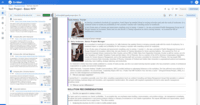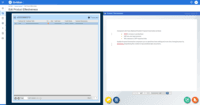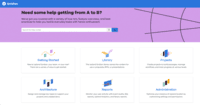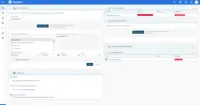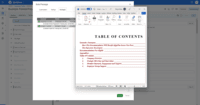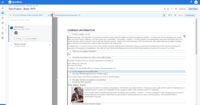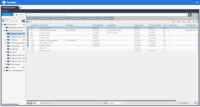Overview
What is Qvidian RFP & Proposal Automation?
Proposal management and RFP response software
Professionnel Service
Say goodbye to troublesome RFPs
Qvidian - it's not just for document management
Qvidian Enables Sales Success!
Review of Qvidian
Really Happy With Qvidian
We love Qvidian at Tyler
Qvidian - A great Content Management Tool
I propose Qvidian
Makes my job easier!
A great tool to increase productivity and end-product quality!
Qvidian from a simple user perspective.
All the features you need with just a couple of small snags along the way.
Qvidian offers best-in-class proposal support
Qvidian succeeds at proposal automation.
Pricing
What is Qvidian RFP & Proposal Automation?
Proposal management and RFP response software
Entry-level set up fee?
- Setup fee optional
Offerings
- Free Trial
- Free/Freemium Version
- Premium Consulting/Integration Services
Would you like us to let the vendor know that you want pricing?
16 people also want pricing
Alternatives Pricing
What is PandaDoc?
PandaDoc headquartered in San Francisco offers their eponymous electronic signature platform for sales teams, containing sales proposal automation and CPQ (configure, price, quote) features, and integration with CRMs.
What is Jotform?
Jotform Enterprise is a digital workspace productivity tool that provides a platform for organizations. The aim of Jotform Enterprise is to give companies an easy-to-navigate tool that makes reaching out to customers, collaborating with coworkers, and collecting e-signatures and data a more…
Product Details
- About
- Integrations
- Competitors
- Tech Details
- FAQs
What is Qvidian RFP & Proposal Automation?
Qvidian RFP & Proposal Automation Features
Proposal Creation & Organization Features
- Supported: Proposal branding
- Supported: Proposal templates
- Supported: Proposal content library updates
- Supported: Guided proposal creation
- Supported: Searchable proposal database
Proposal Collaboration & Workflow Features
- Supported: RFP management & response
- Supported: Proposal collaboration & approval
- Supported: User permissions/proposal editing controls
- Supported: Sales proposal workflow
- Supported: Proposal automation user interface
Qvidian RFP & Proposal Automation Screenshots
Qvidian RFP & Proposal Automation Integrations
- Microsoft Office 2016 (discontinued)
- Microsoft 365
- Salesforce
- Microsoft Office 2010
- Open API
- Google Chrome
- Microsoft Edge
- Firefox
Qvidian RFP & Proposal Automation Competitors
Qvidian RFP & Proposal Automation Technical Details
| Deployment Types | Software as a Service (SaaS), Cloud, or Web-Based |
|---|---|
| Operating Systems | Unspecified |
| Mobile Application | No |
| Supported Languages | English |
Frequently Asked Questions
Qvidian RFP & Proposal Automation Customer Size Distribution
| Consumers | 0% |
|---|---|
| Small Businesses (1-50 employees) | 0% |
| Mid-Size Companies (51-500 employees) | 30% |
| Enterprises (more than 500 employees) | 70% |
Comparisons
Compare with
Reviews and Ratings
(40)Community Insights
- Business Problems Solved
- Pros
- Cons
Qvidian is a powerful tool used by multiple departments within organizations for centralized content management and proposal automation. It is primarily utilized by the Business Development and Marketing departments to streamline the process of responding to customer RFQs, creating business proposals, and answering customer questionnaires. Qvidian provides a centralized location for all proposal content, ensuring the use of the most relevant information and easy management. With its Proposal Automation feature, users can generate semi-custom proposals in less than thirty minutes, saving valuable time. The software also offers easy and fast searching capabilities to find content and answers for tender questions. Qvidian is also used by the legal/compliance team for content organization, maintaining consistency in responses, and periodic review and updates by the legal team. Overall, Qvidian serves as a comprehensive solution to effectively manage and automate the proposal response process companywide, ensuring consistency, efficiency, and streamlined collaboration across departments.
Range of Features: Many users have stated that Qvidian offers a wide range of features that enhance content management, proposal automation, and RFP management. The availability of various features allows users to effectively manage their content, automate the proposal process, and streamline RFP management.
Efficient Searching Capability: Several reviewers have praised the easy and efficient searching capability in Qvidian. The system uses a Google-like approach for quick access to information. This feature enables users to locate specific content quickly, saving time and improving productivity.
Integration with Microsoft Word: Numerous customers highly regard Qvidian's integration with Microsoft Word. This integration allows for seamless editing of records and corresponding metadata within the familiar Word interface. Users appreciate the convenience of editing multiple records in one document, enhancing efficiency in managing their content.
Confusing User Interface: Users have found the user interface of Qvidian to be confusing, particularly in terms of editing records from the library. The overall layout could also have better flow, and navigating the drop-down menus has been challenging for some reviewers.
Performance Issues: Some users have experienced performance issues with Qvidian, including slow editing processes and occasional search failures. Additionally, Qvidian's servers are not always equipped to handle multiple large proposals simultaneously.
Difficult Content Management: Reviewers have mentioned that getting content into Qvidian is laborious and time-consuming. They have also found it difficult to move content within Qvidian after the drag and drop feature was removed.
Attribute Ratings
Reviews
(1-13 of 13)Say goodbye to troublesome RFPs
- Ease of use
- Increased productivity in creating RFPs
- Centralized system to find and utilize stored data
- Slow integration between Microsoft Word and Qvidian RFP & Proposal Automation
- System sometimes lags
- Overall layout could have better flow
We love Qvidian at Tyler
- Using Qvidian as an RFP tool has made a difference in our RFP process, turn-around time, and content development. It's helped us streamline our RFP process so that we are able to produce the majority of the document before the kick-off meeting, which means we have more time to customize and refine the document before it goes to print.
- Additionally, it took several hours before to gather all of the basic data we needed for an RFP, but now we can have the majority of the response ready in under 15 minutes in most cases. We are also able to start projects from our phones (iPhone thru Safari) or on an iPad. This has been extremely helpful while traveling.
- Finally, our content is centrally located on a searchable database. Previously we had used several free tools to aid in content storage that would allow us access easily via search. It never seemed to do what we wanted, and when we did find something, we weren't sure if it was the most current or usable. The library functions in Qvidian have been a huge help, and has changes the way we collect data, and retrieve it.
- The library works great, but the process of moving files from one folder to another is extremely tedious. From what I've heard, there used to be a drag and drop feature in the library. I would like to see thy come back.
- It would be nice to see the final word doc displayed in the project, without having to drill down into it to retrieve it.
- The reports are great to have, but I would like to see a customer driven reporting tool.
Qvidian - A great Content Management Tool
- Qvidian allows for a detailed annotation system for each Question and Answer Pair
- Qvidian allows you to upload Excel, Powerpoint and Adobe documents as user content
- Qvidian offers the capability to run customized reports
- Qvidian allows different levels of access for different users
- Qvidian doesn't always mesh seamlessly with MS Word
- Qvidian's interface isn't very attractive
- Problem shooting isn't always easy or intuitive
Makes my job easier!
- Usability: Qvidian is a mature product. The visual layout is organized in an intuitive manner. The underlting structure is logical and efficient.
- Meta Data: With each file that you load into the Liberty, you can add Meta data such as owner, comments (which I use to record a brief history of the changes that have been made to the file), search terms, expiration date, and alerts. You can even define your own Meta data fields. You can also define specific security permissions to the file or at the folder level.
- Search Function: Qvidian makes it easy to find files by offering basic searches and numerous custom search options that are flexible and easy to use. I have never seen so many search options offered in a program before. In addition to searching for strings in the title or content, you can also search the metadata (for example: comments and specific user-defined search terms). A few examples of advanced search functions include searching by file type, date created or modified, and the person who modified or created it. You can search the entire Library or searches can be defined per specific Library folders.
- Architecting Documents: Defining the document architecture is logical and very flexible. The structure of your document is defined independently of the actual files. This means that you can define the outline of your document first, and then later populate your outline with actual content as it is written. This is a huge help in planning your document structure. Once you load a document into the Library, you then link your document into the architecture. The added benefit of this arrangement is that when you update the document, you do not have to re-link the document back into the architecture. This makes it possible for users who are not knowledgeable about architecting documents to still keep the content current. This is a huge time savings as well as avoids human error.
- Multiple File Formats: Word and Power Point: Qvidian allows you to build documents in Word or PowerPoint. In the Library, you can load almost any file format: Word, PowerPoint, Excel, Visio, PDF, jgp, png, etc. You can also specify additional file formats as needed.
- Qvidian has an excellent support staff. I have called them many times and they are always professional, knowledgeable, and friendly. They are very responsive to any bug fixes and enhancement requests. Qvidian is always working diligently to improve their product.
- There are no major issues that I see at this time that need fixing.
- There is one enchancement that I would love to see... an "Undo" button when working in the Architecture.
A great tool to increase productivity and end-product quality!
- One example of time saved is a request I received from one of our sales people, who needed to reply to a RFP in three days. By using Qvidian, I was able to build a first draft in four hours. Without the program, this feat averages 8-10 hours to pull template, and then another 1-2 hours to do basic customization. With time saved, I was able to review for additional edits, and send of to the sales person by the next morning - leaving her more time to review and edit, and back-end time for me to finalize. Not only did we meet the client's deadline, but we responded a few hours early.
- I constantly receive requests from all areas of my department and the company for template language regarding all of our services. By doing an advance search of our template library, I am able to identify the best response and send it out quickly. For our sales team, this means they are able to respond quickly to a prospect's request, and supports our claims of strong customer service and responsiveness. Personally, it positions me to be a go-to person and reliable teammate.
- Our company has a lot of great data behind our claims, and the ability to create set responses for our merge codes is priceless. I add the information necessary for the merge code and it automatically populates in the project I'm building. As information changes (e.g., number of years in service), as the architect, I edit the data once without having to search through all of my templates.
- Per the merge codes, I recommend having the ability to pull a report that includes the merge codes with their assigned values so that as the architect, I can review a spreadsheet of what information I have, and what needs to be updated.
- Some of the appendices we typically use in RFP responses are in pdf format. The system is unable to combine word and pdf files into one, so adding those pieces are still manual.
Qvidian from a simple user perspective.
- Easy to organize the content library and move things around.
- Ability to put expiration dates on content that needs to be reviewed.
- Automation tool is helpful and if used correctly, will save time and formatting issues.
- Developing an automation template is difficult because of issues of formatting with word and making sure your files are coded right so they pull in.
- When you have an update, we don't always realize it until some of the functions aren't working correctly.
- We have to make an effort to add content because of the preparation it takes (using the right formatting template). We do annual reviews of each section, but I know I have to make time to enter new or update information.
- Organization: Qvidian uses a folder tree layout with user-created top-level categories that can then be branched out into more in depth subcategories. For our own use, our top level categories refer to the various products our company offers (Medical, Pharmacy, Vision benefits, etc.), with the subcategories narrowing down to more specific subjects, such as condition management for Medical and formulary information for Pharmacy.
- Searching: Qvidian uses a Google-like approach to searching. When a user searches for a term or phrase, if the correct record is found and used, then the search term the user had typed in is added to the meta data of that record. Then, in the future, when that same term or phrase is searched again, the record(s) containing that search term appears closer to the top of the search results. Note that users have the ability to preview a record without actually using it, so search terms will only be added to records that are specifically used in a response document.
- Editing: Two choices are offered for editing records, both of which utilize integration with Microsoft Word. In the first choice, records are edited one at a time as separate documents. This allows editing of both the record and its corresponding meta data. For mass record changes, this choice is a bit slower and more inconvenient, since each record can only be seen one at a time, and records can't be compared side-by-side. The second editing choice allows a user to edit multiple records in one document. However, this does not allow a user to edit records' meta data. This trade off does allow for easier editing of multiple records at once, though, since a user can utilize Word's various comparison tools such as a split document screen to see two parts of the document at once.
- One area where Qvidian occasionally struggles is feature regression. For instance, the editing option that puts multiple records into one document had always been present in Qvidian; however, when the multi-edit feature that only allows editing one record at a time was released in version 9.1, the original editing functionality was removed. This caused me a lot of frustration, as it severely slowed down my work flow since I could now only see and edit one record at a time. It wasn't until a year later when version 10 was released that the old editing functionality was added back. However, one bright spot of version 9.1 was an added feature that allowed organizing records by simply dragging and dropping them into different categories. This was much easier than having to right click on a record, select Move, then right click on a folder and select paste. However, with version 10, this feature was removed and I'm now back to having to right click on records instead of dragging and dropping. It seems that with each release, I never know if something I like will be taken away or if something I don't like will be added -- sometimes it's both.
- A recent change that was added in version 10.1 that I personally view as a negative is that Qvidian now handles all requests server side instead of on the user's computer. This means that if a user wants to export or edit a large number of records, they have to wait for Qvidian's server to generate a report of those records. Depending on the number of records, this can be very quick (a few seconds) or very long (I've waited up to 20 minutes before) depending on how taxed Qvidian's servers currently are. I understand the reasoning behind the move, in that it takes the load off of a user's computer so that other applications they currently have open aren't affected by added memory usage, but in practice I find that it only slows down my workflow. Any somewhat modern PC shouldn't have any trouble handling a large report request from Qvidian.
- Although Qvidian is certified for use in several different browsers (Internet Explorer, Firefox, and Chrome for Windows), it doesn't offer the same functionality in each one. For instance, in Explorer, when a record is selected for editing or export, it will automatically open in Word. In Firefox, a pop-up dialog appears and a user has to click Open in order for the record to appear in Word. And in Chrome, the file is added to the download bar and a user must click on the file there for it to open, unless they add an exception to .docx file types to automatically open in Word (which I had to do, since I prefer using Chrome). Other simple features such as right clicking on a folder or record to bring up Qvidian's context menu are hit or miss depending on the browser. In Explorer, everything is generally smooth, though the browser itself is slower than the other choice. In Firefox, right clicking generally works but sometimes has some hiccups, and in Chrome, more often than not right clicking brings up Chrome's context menu instead of Qvidian's, which often leads to having to first select a folder and then click the dedicated Actions button in Qvidian to perform the desired action. No matter which browser you use, there will be some sort of functionality that doesn't quite work as expected.
Qvidian offers best-in-class proposal support
- Advanced searching allows users to quickly find exactly what they're looking for.
- Linking allows for similar content records to be updated at the same time.
- Metadata is a great way to provide underlying information about each content record.
- Due to the sophistication of the technology, the tool can be difficult to bring online in a secure network environment.
- Little opportunity for user interaction or discussion within the tool.
- Some functionality is only available for the automation function, while it would still be useful for warehousing functions (merge codes, SalesForce integration, etc.).
Qvidian succeeds at proposal automation.
- The search function ranks information based upon usage and is adaptive, learning/improving rankings with every search. This makes finding the right piece of information quick and easy.
- The tool offers flexibility to build various types of sales documents (proposals, presentations, case studies). This drastically reduces the time it takes to put together a client-facing document.
- The content management functionality allows for various content formats and related content can be connected. This simplifies tracking content updates by knowing which other pieces of information may also need review and update when a change is made outside the normal update cycle.
- Qvidian could improve their reporting functionality. Currently, it requires special coding to pull data points into a spreadsheet format and there are no intrinsic analysis (dashboard) views for the user or management.
- The question highlight then search functionality has not worked for me or my team in MS Excel. We have to actively type key words into the search function to find content. It works but slows the process a bit. Would love to see them remedy this issue as this is a very common format for our commercial opportunities especially with the increased use of online procurement portals.
Could be better with some tweaks!
- You can add a lot of information about each individual record, giving it an owner, expiration date, etc.
- Expiration dates are clearly seen, and it is easy to tell which records are new (blue) vs. old (red).
- I like how you can search the entire database, or just specific folders for a word or group of words.
- It is extremely difficult to move a record from one folder to another.
- Updating records, as well as adding new records, require many steps and it is not always straightforward.
- The database uses a natural word search, like Google. If you do not know exactly how the question is worded, you may have to try multiple times to find it. We had a older database that searched using keywords, and we found that it was much easier to find the data you were looking for.
Qvidian review within an RFP Desk
- The ability to use a style template that will have all of the data formatted consistently
- The ability to have document automation allows you to create cover letters in a matter of minutes
- Merge codes are an efficient way to update changing content
- The drop down menus can be difficult to navigate
- Sometimes the support staff "quizzes" too much about the problem instead of getting on a WebeEx to look at the issue
- The Community can be difficult to navigate and find your answer
Qvidian - Notes From a Power User
- Qvidian is highly customizable. This is a strength for the organization that has specialized needs and preexisting structures.
- Qvidian support and data migration services were especially valuable because we had a great deal of information in our previous system that we did not want to lose.
- I was impressed by Qvidian's ability to integrate with MS Office
- I was frustrated that browser settings had to be so finely tuned to use the software. This was especially challenging in a company that had existing stringent IT browser settings. It made final implementation of the software challenging.
- I was initially frustrated by the inability to copy and paste from the preview window.
Good for proposal branding consistency; reporting clunky.
- Organizes content in a consistent structure. Allows for Mandatory Content and Optional Content within an overall document framework.
- Maintains branding through Word templates/themes.
- Allows for the mix of “boilerplate” content, while giving the ability to personalize based on “edit codes”, such as using organization name throughout a proposal, using specific examples or images based on a given vertical/industry etc.
- A knowledge base/repository for question/answer pairs for RFP Allows “upload” of RFP questions and potentially “automatic” answering based on most popular answers given key words.
- Integrates to Salesforce.com, though we have not taken advantage, so I’m unsure to what degree it integrates. I assume it will allow to pull in contact name, address, etc.
- Until the latest release, the UI was getting “old”. The process of architecting a document seemed backwards (start with the specific content, then build an outline. It has since been fixed in newer versions.
- Not compatible with all browsers, or not latest version of browsers.
- Content still requires post-build editing for spacing around table of contents.
- Some users struggle with setup of Internet Explorer, macros and/or template styles, etc.
- Reporting is clunky.
- Does not have ability to configure pricing quotes.

